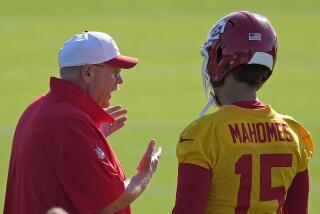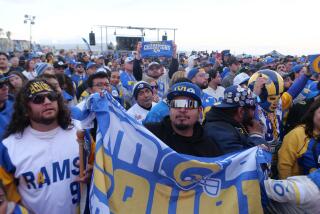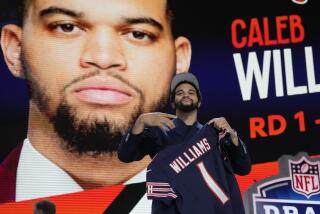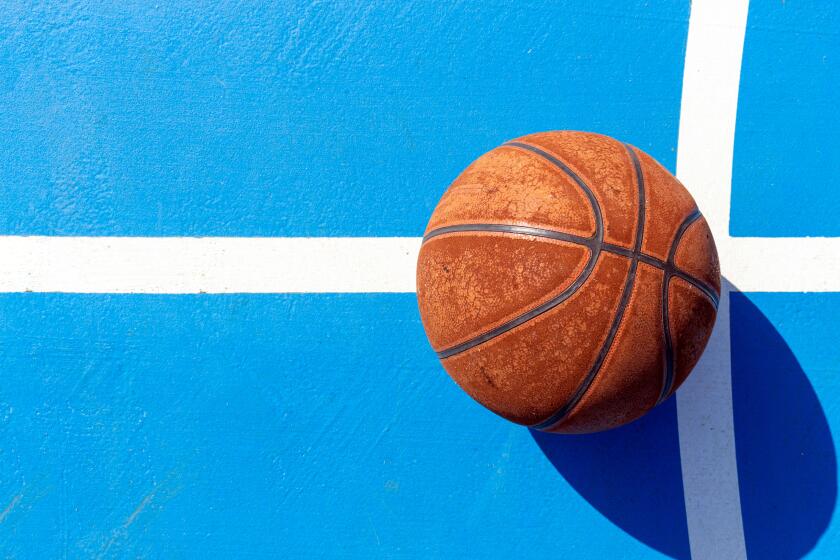In NFL Draft, It’s Not What You Are, but Who You Are
- Share via
A stopwatch? Stuart Weinstein doesn’t need one. Game film? Weinstein never touches the stuff. College statistics? Let the Miami Dolphin number crunchers worry about those.
Weinstein is the team’s combine Columbo.
Sure, a star receiver can take it to the house, but has he ever been taken to the big house?
Weinstein knows. He’s a former private investigator who plows through court papers the way Ricky Williams plows through a 3-4 defense. As of Wednesday, Weinstein had done interviews and corresponding background checks on 424 prospects. By Saturday, the first day of the NFL draft, he plans to have scoured the legal history of every potential pick.
“In some cases, you’re making a million-dollar-plus decision,” said Weinstein, who 19 years ago went from serving subpoenas and conducting polygraph tests to doing background checks on college football players, first for the NFL then the Dolphins, for whom he’s the security investigator.
It’s a growing trend. The Eagles use a former Philadelphia police officer to do similar background checks. The Rams employ the retired police chief of Kirkwood, Mo. And Lewis Merletti, a former director of the U.S. Secret Service, has similar responsibilities in his role as security director for the Cleveland Browns.
“The process is exponentially more thorough now than it was in the past,” player agent Leigh Steinberg said. “Every aspect of a player’s background is checked. NFL teams are using services that are checking on every arrest, checking for substance abuse, asking questions on campus, talking to anyone and everyone.”
The league does its own background checks on prospects who attend the NFL combine at Indianapolis, and some teams rely primarily on those reports. Investigators such as Weinstein come in handy, though, when a team wants a more thorough check or is looking at an out-of-the-mainstream player.
Sometimes, running a background check on a player requires little more than picking up the newspaper. Two of the top prospects in this year’s draft, Arizona State defensive end Terrell Suggs and Michigan State receiver Charles Rogers, have made headlines recently for all the wrong reasons.
Suggs had a horrible workout for scouts last month, then watched his stock dip even lower after he was involved in a fight at a three-on-three basketball tournament. Once considered a possible No. 1 pick, he might have tumbled out of the top five.
It was revealed last week that Rogers, another potential No. 1 pick, failed a drug test in February because there was too much water in his urine. Excessive water is considered a masking agent under the league’s drug policy. How the transgression will affect Rogers’ draft status is unclear.
Rogers dismissed the setback as nothing more than a “speed bump” and said he still expected to hear his name called almost immediately on draft day.
“I’m in the same situation as I was last week; I will go no lower than two,” he told reporters Thursday. “I think there’s still a possibility Houston will move up to No. 1 to get me, and if they don’t, Detroit will.”
Rogers and Lion President Matt Millen spoke Monday when the receiver visited team headquarters. Millen declined to address whether the diluted urine sample changes how the Lions view Rogers.
“We’ve heard nothing but good on him,” said Millen, whose team drafts in the second slot, behind Cincinnati. “He’s a kid who has great skills, obviously, and a personality to match. I think he would be a great fit here.”
This much we know: There are no secrets anymore. Shortly after the league released a memo to teams about Rogers’ drug-test results, the news was crawling across TV screens all over the country.
“In other industries, that level of scrutiny would be illegal,” Baltimore Coach Brian Billick said. “When we read about the activities of some of these players, it’s because they are held to a higher level of scrutiny. That’s become more and more apparent to the players.”
Billick laughs about the time he sat down at the combine two years ago with a prospect who had gotten into some trouble during his college career.
“He was a very nice young man,” the coach said, “so I asked him flat out: ‘Are you a thug, or are you just stupid?’ ”
“Are those my only choices?” asked the prospect, who scored points with his response.
Sometimes when you’re evaluating a prospect, Billick said, you have to look beyond the rap sheet and go with your gut. Billick was Minnesota’s offensive coordinator five years ago when the Vikings used the 21st pick on Randy Moss, who had had several run-ins with the law as a college player. He easily was talented enough to be the first player chosen, but his sketchy past caused him to tumble out of the top 20.
“You’re talking about young people, and young people do stupid things at times,” Billick said. “Sometimes you have to make the judgment of, indeed, is this kid a bad person? Is he a thug? Is he someone that you’re going to have continual problems with because they are a bad person at heart? Or, are they just young and stupid?”
Although he was surly and at times immature as a young pro, Moss stayed out of trouble off the field and rocketed to the top of the receiving charts, earning rookie-of-the-year honors from several publications. The Vikings strolled away with the steal of the draft.
“I was very impressed with the way Randy was so conscious about trying to do the right thing,” Billick said. “Now, as far as saying the right thing and being socially correct, yeah, clearly the guy’s got a way to go. But actually keeping himself away from those things that could pull him down, I was very impressed with the way Randy conducted himself.”
Moss ran afoul of the law again in September when he spent the night in jail after allegedly pushing traffic agent Amy Zaccardi half a block with his car. Zaccardi has filed a civil suit against him. And, on a lighter note, the St. Paul Saints, a minor league baseball team, plan to give away a Randy Moss hood ornament to 2,500 fans at a game Aug. 16.
“Even this recent incident with the traffic cop, had it not been Randy Moss, had it not been someone with a previous history, had it not been someone who has been so much in the public eye because of his conduct on the field, this is a non-incident,” Billick said. “This is something [the media] doesn’t even report.”
Philadelphia Coach Andy Reid said he considered good character one of the most important values when evaluating a player, and not just because millions of dollars could be on the line.
“Good guys in tough times reach a little deeper,” said Reid, named coach of the year last season. “A handful of times in a game, you’re going to reach some pretty tough times. And very few teams go undefeated, so it can be a tough week after a loss. Good guys can deal with that better.”
Miami’s Weinstein said he didn’t have the authority to disqualify a player from the Dolphin draft board -- that responsibility lies with Coach Dave Wannstedt, Player Personnel Director Rick Spielman, and others -- and was less concerned about whether a prospect, say, pays his bills than more serious offenses.
“We all make mistakes, especially in college,” Weinstein said. “We’re not going to not take a kid because he messed up once or twice, as long as he learned from his mistakes. We’ve rolled the dice, sometimes successfully and sometimes not successfully, on student-athletes.”
New England rolled the dice seven years ago in drafting Nebraska defensive lineman Christian Peter, although Patriot officials said they had been unaware of the player’s troubled past. Days after making him a fifth-round pick, the team waived him. Peter had pleaded no contest to grabbing a woman by the throat in a bar. He also had pleaded no contest to sexually assaulting a former Miss Nebraska, and had been arrested for trespassing, urinating in public, refusing to comply with the order of a policeman and threatening to kill a parking attendant.
Team officials said Patriot owner Bob Kraft gave the go-ahead to draft Peter, then made the decision to waive him. Peter, now in his second season with the Chicago Bears, subsequently spent four seasons with the New York Giants and one with Indianapolis.
Some teams go to extraordinary lengths to compile a psychological profile on prospects. The Giants give players a written test that used to require about three hours but since has been streamlined to about half that. Pittsburgh linebacker Kendrell Bell took that exam two years ago and said it asked 434 questions.
“They asked questions like, ‘Do you love your family? Do you have a dog? Do you like your dog?’ ” Bell recalled.
Yes, some of the questions were probing, but that didn’t bother Bell.
“You basically sign your life away when you get in a draft situation,” he said.
Twenty years ago, Dan Marino fell to the 27th pick in the draft -- behind fellow quarterbacks John Elway, Todd Blackledge, Jim Kelly, Tony Eason and Ken O’Brien -- largely because of unsubstantiated rumors that he was a drug user. There was nothing in his stellar career with the Dolphins to suggest there was any truth to those murmurs, however, and Marino now is headed for the Pro Football Hall of Fame.
Old rumors don’t die easily, though. Marino recently was approached at a charity event and asked what he remembered about that trying time.
“It’s been 20 years and you guys are still talking about that stuff?” he huffed, shaking his head as he turned and walked away.
Associated Press contributed to this report.
*
(BEGIN TEXT OF INFOBOX)
Draft Order
The NFL draft is April 26-27 in New York:
1. Cincinnati Bengals
2. Detroit Lions
3. Houston Texans
4. Chicago Bears
5. Dallas Cowboys
6. Arizona Cardinals
7. Minnesota Vikings
8. Jacksonville Jaguars
9. Carolina Panthers
10. Baltimore Ravens
11. Seattle Seahawks
12. St. Louis Rams
13. a-New York Jets
14. b-New England Patriots
15. San Diego Chargers
16. Kansas City Chiefs
17. New Orleans Saints
18. c-New Orleans Saints
19. New England Patriots
20. Denver Broncos
21. Cleveland Browns
22. New York Jets
23. d-Buffalo Bills
24. Indianapolis Colts
25. New York Giants
26. San Francisco 49ers
27. Pittsburgh Steelers
28. Tennessee Titans
29. Green Bay Packers
30. Philadelphia Eagles
31. Oakland Raiders
32. e-Oakland Raiders
a-from Washington, b-from Buffalo, c-from Miami, d-from Atlanta, e-from Tampa Bay.
Junior Achievement
This year’s draft includes the largest number of underclassmen:
* Players leaving early in 2003...45
* 2002...36
* 2001...39
* 2000...26
* 1999...35
* 1998...32
More to Read
Go beyond the scoreboard
Get the latest on L.A.'s teams in the daily Sports Report newsletter.
You may occasionally receive promotional content from the Los Angeles Times.











